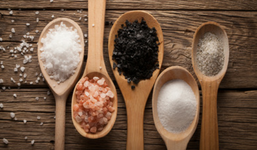 |
|
SPOTLIGHT |
|
|
|
|
|
| Get Salty Hawaiian Style |
Traditionally held in high regard by Native Hawaiians, pa’akai — the coarse salt referred to as Hawaiian sea salt today — was often mixed with red alae clay and used in ceremonies to cleanse, bless, and even heal. The Hawaiian people originally made their salt by evaporating sea water, but later began digging large salt pans into red, iron rich volcanic clay to increase production to support increasing trade with Europeans. Today, Hawaiian sea salt is praised for its high mineral content and rich flavor and has gained popularity around the world.
Founded in 2007 by artist Joanna Carolan, Hanapepe, Kauai based Aloha Spice Company originally offered only a small selection of spice rubs that included Hawaiian salt as an ingredient. Joanna began selling the pure salt because of customer requests, and today the company offers a wide variety of Hawaii salt made from solar-evaporated sea water.
Aloha Spice Company sources their Hawaiian salt from Molokai and brings in “enough to nearly break our pickup truck!” says Eamonn Carolan, Joanna’s step son and general manager of the company. Sea water is filtered on Molokai, evaporated down to concentrate the salt, and then evaporated even more. “It’s a months-long process,” says Eamonn.
Once Aloha Spice Company has the salt in hand, three fulltime salt makers go to work producing products such as Kuakea White, Alaea Red, and Black Lava sea salts; flavored salts like the Kiawe Smoked Garlic; and seasoning rubs like Pele’s Smokey Coffee Rub.

Interested? Here’s a bit more information to “salt away!”
|
Salt of the Earth: Today, red alaea salt is infused with a special Hawaiian clay that is added toward the end of the refining process. The red color comes from iron oxide, a naturally occurring mineral in the soil. The earthy quality of the clay mellows the bite of the salt and adds a subtle flavor. Aloha Spice Company’s Fine Grain Alaea Salt is the company’s most popular salt.
More than a Grain of Salt: Sea salt can be sold in flaky form, or as crystalline grains, ranging from coarse to fine. Flaky salt — which Aloha Spice Company uses in its smoked salts — is dried in thin layers, using a shallower, larger container to hold the water, explains Eamonn. To make the salt sold in chunkier, crystalline shapes, a deeper box is used to evaporate the salt water.
A Pinch of Salt: Eamonn recommends using Hawaiian salt both at the beginning and end of the cooking process. He suggests using the coarse grain salts to season first, then finishing the dish with a flaky salt. Try a pinch of flaky salt on your salad or add a smoked salt rim to a margarita for a special finishing touch.
The Favorite: Eamonn says his favorite salt is the Smoked Onion, which is a fine-grain red salt, smoked with kiawe and onions for 20 hours. “But if I had to choose just one, it would be the plain white sea salt because it’s the most versatile, a ‘survival salt,’” he says.
|
|
|
|
| Did You Know? |
 |
 |
| While all salt is technically “sea” salt because it all comes from sea water, the salt sold as “sea salt” is freshly harvested from the ocean. Table salt, in contrast, is mined from ancient salt deposits left in the earth. When you buy Hawaiian sea salt, Eamonn says, you’re buying “something that’s made closer to home and has less impact on the environment.” |
|
|
|
|
 |
|
RECIPES |
|
|
|
|
|
|
|
| This versatile, all-in-one seasoning mix is perfect for seasoning meat, chicken and pork before grilling! Use instead of salt and pepper, sprinkling evenly on the surface area of meat before cooking. |
| INGREDIENTS |
- 1 tablespoon powdered ginger
- 4 tablespoons granulated onion
- 4 tablespoons crushed black pepper
- 1 pound Alaea Red Hawaiian salt
|
| INSTRUCTIONS |
| Combine all ingredients and mix. Store in a dry, airtight container until ready to use. |
|
 |
| Did you make this recipe? |
| Let us know how it turned out for you! Share a picture on Instagram with the hashtag #FoodlandEatLocal |
|
| How can you tell it’s local? |
| Look for the ORANGE SIGNS |
| to find locally grown and locally made items throughout our stores. |
|
|
|
|
|
|
|

